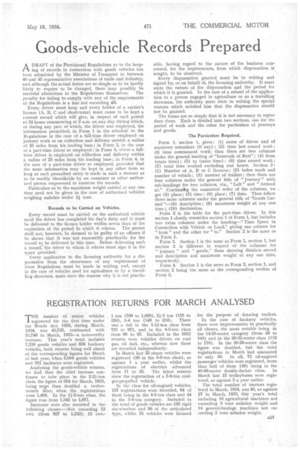Goods-vehicle Records Prepared
Page 37

If you've noticed an error in this article please click here to report it so we can fix it.
A DRAFT of the Provisional Regulations as to the keep
ing of records in connection with goods vehicles has been submitted by the Minister of Transport to between 40 and 45 representative associations of trade and industry, and although the actual forms are so simplo as to be hardly likely to require to be changed, there may possibly be material alterations in the Regulations themselves. The penalty for failing to comply with any of the requirements of the Regulations is a fine not exceeding £5.
Every driver must keep and every holder of a carrier's licence (A, B, C and short-term) must cause to be kept a current record which will give, in respect of each period of 24 hours commencing at 2 a.m. on any day during which, or during any part of which, the driver was employed, the information prescribed, in Form 1 in the schedule to the Regulations in the case of a full-time driver employed on journey work or on collection and delivery outside a radius
of 25 miles from his loading base ; in Form 2, in the case of a part-time driver so employed ; in Form 3, where a fulltime driver is employed on collection and delivery within a radius of 25 miles from his loading base ; in Form 4, in the case of a part-time driver so employed, provided that the same information may be kept in any other form so long as each prescribed entry is made in such a manner as to be readily identifiable by an examiner or other authorized person empowered to examine the records.
Particulars as to the maximum weight carried at any one time need not be given in the case of authorized vehicles weighing unladen under 21. tons.
Records to be Carried on Vehicles.
Every record must be carried on the authorized vehicle until the driver has completed his day's duty, and it must be delivered to the licence holder within seven days of the expiration of the period to which it relates. The person shall not, however, be deemed to be 'guilty of an offence if he shows that ft was not reasonably practicable for the record to be delivered in this time. Before delivering such a record: the driver to whom it relates must sign it in the space provided.
Every application to the licensing authority for a dispensation from the observance of any requirement of these Regulations must he made in writing, and, except in the case of vehicles used for agriculture or by a travelling showman, must state the reasons why it is not practic
able, having regard to the nature of the business concerned, for the requirements, from which dispensation is sought, to be observed.
Every dispensation granted must be in writing and signed by, or on behalf of, the licensing authority. It must state the nature of the dispensation arid the period for which it is granted. In the case of a refusal of the application to a person engaged in agriculture or as a travelling showman, the authority must state in writing the special reasons which satisfied him that the dispensation should not be granted.
The forms are so simple that it is not necessary to reproduce them. Each is divided into two sections, one for the period of work and the other for particulars of journeys and goods.
The Particulars Required.
Form 1, section 1, gives: (1) name of driver and of statutory attendant (if any) ; (2) time last ceased work ; (3) time commenced work; then there are two columns under the general heading of "Intervals of Rest" ; (4) from (state time) ; (5) to (state time) ; (6) time ceased work ; (7) total time worked excluding rest hours. Section 2: (1) Number of A, B or C licences ; (2) index mark and number of vehicle; (3) number of triflers; then there are four columns under the general title of " Journey " with sub-headings for two columns, viz., " Left " and 'Arrived at." Continuifig the numerical order of the columns, we get (4) place; (5) time ; (6) place; (7) time. Then follow three more columns under the general title of "Goods Carried "—(8) description ; (9) maximum weight at any one time ; (10) destination.
Form 2 is the table for the part-time driver. In this section 1 closely resembles section 1 of Form 1, but includes two extra columns under the heading—" Time Spent in Connection with Vehicle or Load," giving one column for " from " and the other for "to." Section 2 is the same as in Form 1.
Form 3. Section 1 is the same as Form 1, section 1, but section 2 is different in respect of the columns for " journey " and " goods," these showing districts served and description and maximum weight at any one time, respectively. Form 4. Section 1 is the same as Form 2, section 1, and section 2 being the same as the corresponding section of Form 3.




















































































